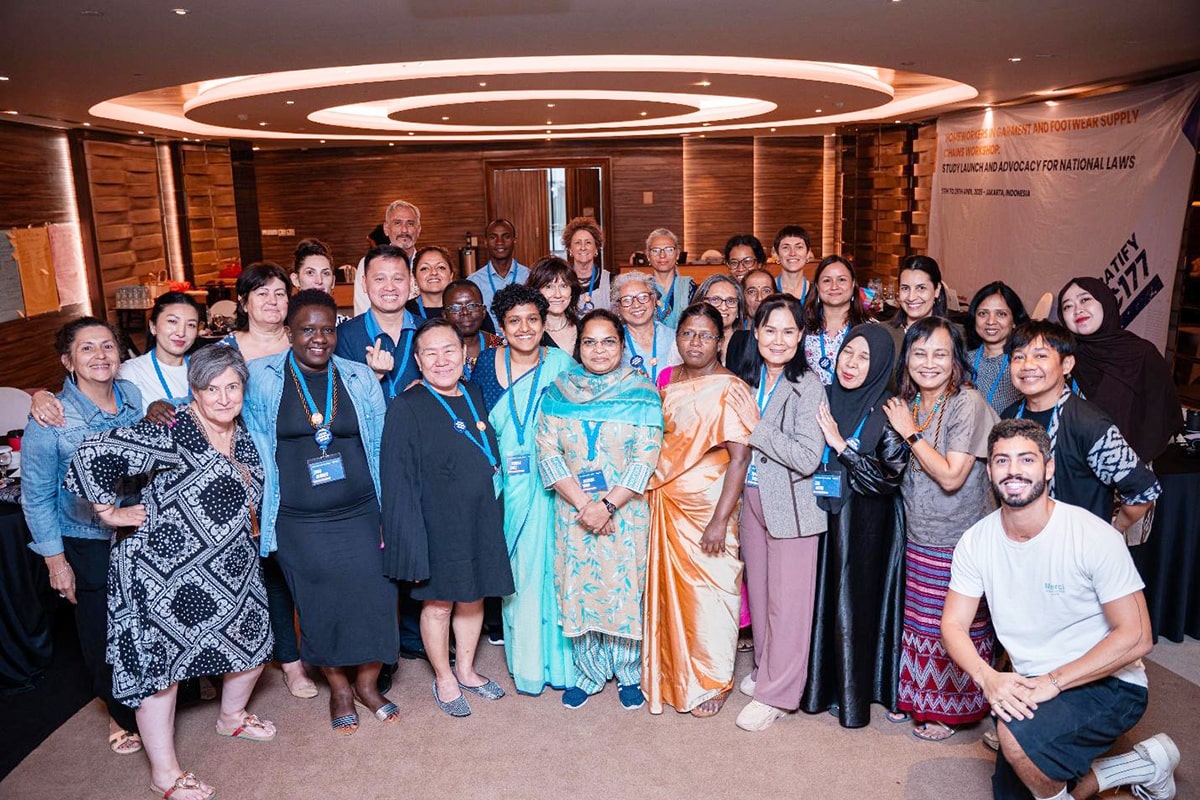By: Sarbani Kattel, HNI Programme Coordinator
In April 2025, HomeNet International (HNI) launched its first global study, “State of Homeworkers in Garment and Footwear Supply Chains,” in Jakarta, Indonesia. This study was HNI’s first study to go beyond Asia, incorporating insights from countries in Latin America, Africa, Eastern Europe, and Central Asia. As part of the launch, one of the sessions invited participants to map their respective supply chains. The purpose was to unpack and reflect on the realities faced by homeworkers within these chains across different regions. This exercise revealed important insights into the structures, relationships, and vulnerabilities present in various contexts.
South Asia’s Invisible Labor and Low Pay:
In South Asia, informality and low pay were powerfully voiced by participants. For instance, in Pakistan, extremely low and disproportionate earnings of Home-based Workers (HBWs) compared to the market values of finished products were highlighted. A complete suit sells for anywhere between ₹4,000 (USD 14) and ₹15,000 (USD 150) at retail. However, home-based workers who contribute significant value to the finished product receive: ₹8 (USD 0.028) for full stitching; ₹2 (USD 0.007) for hemming (a task that takes 15–30 minutes and requires precision); and ₹1 (USD 0.0035) for button sewing. Workers are aware of this gap but have no bargaining power due to their informal and invisible position in the supply chain.
In Nepal, women who produce intricate woolen items—such as caps, ponchos, and mittens—for export face similar issues. Despite the craftsmanship involved, a cap that sells for USD 17 in Europe earns the worker just 80 Nepali rupees (approximately USD 0.58). Verbal agreements, inconsistent training, and a lack of price transparency place these skilled homeworkers in a vulnerable position.
In Tirupur, Tamil Nadu, the garment supply chain spans from cotton ginning to export. Home-based workers—many former factory employees—are responsible for stitching, embroidery, and labeling, yet earn less than half the factory wage for the same tasks. Meanwhile, in Ahmedabad, home-based workers earn low wages and know little about the final product or buyer.
Across these countries, low pay with no contracts, formal protections, or transparency dominate—a recurring theme. Participants called for better pay, legal recognition, contract formalization, and brand accountability.
East Africa: Fragmented, Yet Entrepreneurial
In Uganda, Kenya, and Rwanda, home-based workers operate as self-employed producers, creating bags, shoes, and garments from purchased raw materials. While they enjoy some autonomy, the absence of collective pricing, brand recognition, and competition leaves them exposed to exploitation by middlemen—who choose cheaper options. Organizing efforts are beginning to emerge, focusing on standardizing prices and building market access.
Latin America: Relabeled Labor and Deceptive Value
From Argentina to El Salvador, HBWs are engaged in garment production and labeling work. Many report being paid little to relabel products imported from Asia as locally made. An example mentioned was the practice of importing products (e.g., garments) from countries like China, Vietnam, or Bangladesh to Latin American countries. These products are then relabeled as though they were locally produced, such as “Made in Argentina” or “Made in Uruguay.” This relabeling is often facilitated by HBWs in informal workshops, yet they are paid very little despite being part of a deceptive branding process that increases product value and market price. Formal recognition, transparent contracts, and wage standardization were emphasized as urgent needs.
Southeast Asia: Between Local Markets and Global Chains
In Vietnam, two types of supply chains coexist. Local chains allow some price negotiation and direct sales but offer no security. Export-oriented chains are longer and more exploitative, involving subcontractors who distribute tasks to HBWs via oral agreements. With no legal recourse in case of disputes, HBWs remain deeply precarious. Thailand presents a more structured example, thanks to the Homeworkers Protection Act passed in 2010. For instance, registered HBW groups producing patchwork garments from factory scraps are calling for fair treatment. These remnants, which would otherwise go to waste, are creatively reused to make patchwork cloth, which is then returned to factories for final garment production. While this model includes quality checks and a small welfare fund, participants emphasized the need to advocate not only for minimum wage parity with factory workers but ultimately for a living wage for home-based workers.
In the Philippines, nano-producers coordinate multi-layered subcontracting chains involving up to nine levels of workers. Production is informal, payments are verbal, and platforms like Shopee, Lazada, and TikTok dominate sales—with no direct sales happening from homes or workshops. Orders are fulfilled by the producer or logistics partners. None of the value flows back to the workers.
Indonesia mirrors this informality: brands pass orders to contractors who delegate to group leaders and HBWs. No written contracts exist between workers and those higher up the chain, and training is rarely provided by brands; home workers must figure out production techniques independently, often self-taught through YouTube. Though some HBW groups sell to regional buyers, they remain largely disconnected from formal protections.
Serbia: Tradition Meets Informality
In Serbia, homeworkers weave traditional Serbian cloth on wooden looms but face steep taxation barriers that prevent formal registration. Many sell through associations or the black market to survive. The same product earns the same amount whether made in a factory or by hand—raising hard questions about fairness and labor value.
Home-Based Workers’ Demands:
From the exercise, the supply chains differed in structure, but the challenges were strikingly similar: informality, low pay, lack of contracts, limited bargaining power, and significant value extraction by intermediaries. During the session, one message was clear: mapping supply chains is only the beginning. What’s needed now is:
- Formal recognition of home-based workers across all regions
- Transparent and enforceable contracts
- Living wages, not just minimum wage parity
- Collective bargaining mechanisms and organizing support
- Regional cooperation to avoid undercutting and promote fair competition
As home-based workers across continents continue to stitch, knit, pack, and label the world’s garments and goods, global brands, governments, and consumers must recognize their labor, protect their rights, and share the value equitably.



